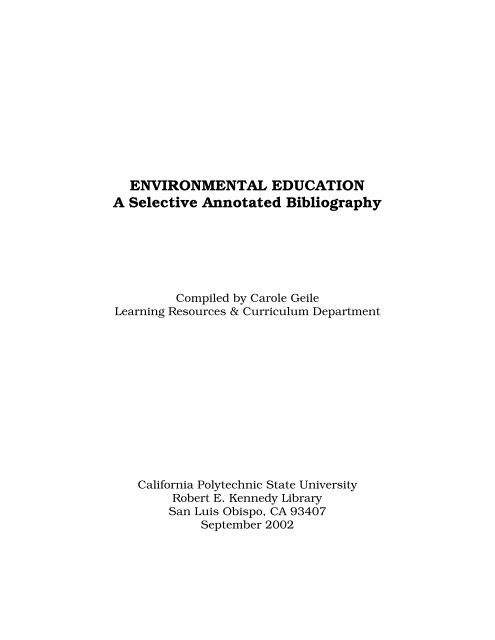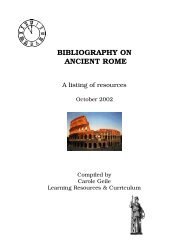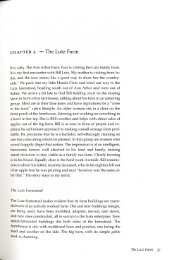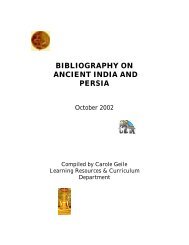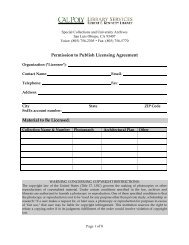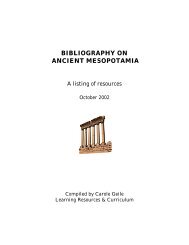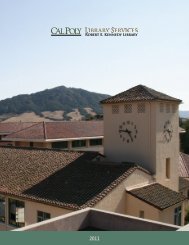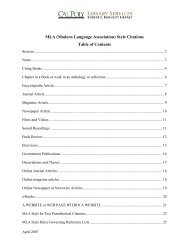Environmental Education - Robert E. Kennedy Library
Environmental Education - Robert E. Kennedy Library
Environmental Education - Robert E. Kennedy Library
Create successful ePaper yourself
Turn your PDF publications into a flip-book with our unique Google optimized e-Paper software.
ENVIRONMENTAL EDUCATION<br />
A Selective Annotated Bibliography<br />
Compiled by Carole Geile<br />
Learning Resources & Curriculum Department<br />
California Polytechnic State University<br />
<strong>Robert</strong> E. <strong>Kennedy</strong> <strong>Library</strong><br />
San Luis Obispo, CA 93407<br />
September 2002
BOOK RESOURCES<br />
Activity book: NASA Lewis Research Center: Earth Day everyday: "for the<br />
benefit of all". Cleveland, OH: National Aeronautics and Space Administration,<br />
Lewis Research Center, 1997. (WT 500.2 E/NASA AC85B)<br />
Summary: Earth Day celebrations activity programs.<br />
Amdur, Richard. The fragile earth. New York: Chelsea House, 1994. (WB<br />
550 AMD29F)<br />
Summary: Describes the characteristics of the Earth from the time of the Big<br />
Bang through the development of life (including human life) to the<br />
present day; focuses on threats to the environment. Grades 5 and<br />
up.<br />
Anderson, Joan. Earth keepers. San Diego, CA: Harcourt Brace & Company,<br />
1993. (WB 363.735 AND23E)<br />
Summary: Discusses the work of three environmental protection groups who<br />
are striving to help save the Earth from destruction. Grades 4 and<br />
up.<br />
Appelhof, Mary. Worms eat our garbage: classroom activities for a better<br />
environment. Kalamazoo, MI: Flower Press, 1993. (WT 500.2 E/ZAPP<br />
W894E)<br />
Summary: A curriculum emphasizing earthworms and their habitats, needs,<br />
physical descriptions, and relationships to other living things by<br />
integrating activities in soil science, plant growth studies, and<br />
ecology. Grades 6 and up.<br />
Arms, Karen. Holt environmental science. Austin, TX: Holt, Rinehart and<br />
Winston, 1996. (WS 577 AR56H)<br />
Summary: A textbook designed to educate students in environmental<br />
science, covering ecology, ecosystems and biomes, the effect of<br />
man on both the natural and the human environment, and<br />
exploring the various scientific methods used in environmental<br />
science. Grades 9-12.<br />
2
Arnold, Caroline. On the brink of extinction: the California condor. San Diego,<br />
CA: Harcourt Brace Jovanovich, 1993. (WB 598.91 ARN64O)<br />
Summary: Describes the history of the condor in North America and the<br />
efforts to capture and breed the few remaining California condors<br />
to save them from extinction. Grades 4-7.<br />
Arthur Carhart National Wilderness Training Center. The wilderness & land<br />
ethic curriculum: kindergarten through 8th grade. Huson, MT: Arthur<br />
Carhart National Wilderness Training Center, 1996. (WT 500.2 E/ZART<br />
W645A 1996)<br />
Summary: Develops an awareness of the wilderness resource and its<br />
significance to our culture and society. Designed for use in urban<br />
classrooms without dependence on field experience, though many<br />
activities are adaptable to a field setting. Grades K-8.<br />
Asimov, Isaac. What's happening to the ozone layer? Milwaukee, WI: Gareth<br />
Stevens Publishing, 1992. (OVR WB 363.73 ASI42W)<br />
Summary: Describes the ozone layer and its ongoing destruction and<br />
explains what can be done to help solve the problem. Grades 1-8.<br />
Bang, Molly. Common ground: the water, earth, and air we share. New York:<br />
Blue Sky Press, 1997. (WB 363.7 BAN224C)<br />
Summary: Imagines a village in which there are too many people consuming<br />
shared resources and discusses the challenge of handling our<br />
world's environment safely. Grades preS-5.<br />
Barss, Karen. Clean water. New York: Chelsea House Publishers, 1992. (WB<br />
363.7394 BAR28C)<br />
Summary: Discusses the problem of maintaining a clean water supply and<br />
relates this issue to such topics as pollution, depletion of sources,<br />
and other environmental concerns. Grades 5 and up.<br />
The Big book for our planet. New York: Dutton Children's Books, 1993. (OVR<br />
WB 808.8 BIG48B8)<br />
3
Summary: Nearly thirty stories, poems, and non-fiction pieces by such<br />
notable authors as Natalie Babbitt, Marilyn Sachs, and Jane<br />
Yolen, illustrated by the likes of Steven Kellogg and Susan Jeffers,<br />
demonstrate some of the environmental problems now plaguing<br />
our planet, e.g. overpopulation, tampering with nature, litter,<br />
pollution, and waste disposal. Grades 2-7.<br />
Braus, Judy. <strong>Environmental</strong> education in the schools: creating a program that<br />
works! Washington, DC: North American Association for <strong>Environmental</strong><br />
<strong>Education</strong> (NAAEE) in conjunction with the ERIC Clearinghouse for Science,<br />
Mathematics, and <strong>Environmental</strong> <strong>Education</strong>, The Ohio State University, 1994.<br />
(WT 500.2 E/ZBRA E89E)<br />
Summary: Helps Peace Corps Volunteers, teachers, and others concerned<br />
with environmental education develop effective programs<br />
regardless of student age or geographic location.<br />
Brown, Paul. Greenpeace. New York: New Discovery, 1994. (WB 363.705<br />
BRO814G)<br />
Summary: This is the story of the international, nonviolent, nonpolitical<br />
organization, founded in 1971 to protect the world’s environment.<br />
Grades 6 and up.<br />
Bryant, Jennifer. Marjory Stoneman Douglas: voice of the Everglades.<br />
Frederick, MD: Twenty-first Century Books, 1992. (WB 921 DOU746B)<br />
Summary: Traces the life of the woman who became known as the<br />
"Grandmother of the Glades" for her fight to preserve the Florida<br />
Everglades against misuse and development. Grades 4-7.<br />
Burrill, Richard. Protectors of the land: an environmental journey to<br />
understanding the conservation ethic. Sacramento, CA: Anthro Company,<br />
1994. (WT 500.2 E/ZBUR P946O)<br />
Summary: The aim of this book is to build greater self-worth and respect for<br />
the natural California landscape by experiencing values of the<br />
California Indians.<br />
4
Caduto, Michael J. Keepers of life: discovering plants through Native<br />
American stories and earth activities for children. Golden, CO: Fulcrum<br />
Publishing, 1994. (OVR WB 398.07 CAD115K2)<br />
Summary: This book focuses on environmental and stewardship issues that<br />
affect plants in our modern world, including crucial environmental<br />
topics such as global warming, ozone depletion, acid rain, and<br />
endangered species. Grades 1-6.<br />
Caduto, Michael J. Keepers of life. Teachers guide: discovering plants through<br />
Native American stories and Earth activities for children. Golden, CO: Fulcrum<br />
Publishing, 1995. (OVR WB 398.07 CAD115K2 TM)<br />
Summary: Teacher's guide to accompany Keepers of Life, a collection of<br />
Native American stories from across North America. Grades 1-6.<br />
Caduto, Michael J. Keepers of the animals: Native American stories and<br />
wildlife activities for children. Golden, CO: Fulcrum Publishing, 1992. (OVR<br />
WB 398.07 CAD115K3)<br />
Summary: This book provides a program of study in the important concepts of<br />
wildlife ecology and environmental issues concerning animals.<br />
Grades 1-6.<br />
Caduto, Michael J. Keepers of the animals teacher's guide: Native American<br />
stories and wildlife activities for children. Golden, CO: Fulcrum, 1992. (OVR<br />
WB 398.07 CAD115K3 TM)<br />
Summary: This Teacher’s Guide takes you and your children from the tales to<br />
lessons that teach about all of the major groups of animals, wildlife<br />
ecology and related environmental issues as well as Native North<br />
American cultures. Grades 1-6.<br />
Caduto, Michael J. Keepers of the night: Native American stories and<br />
nocturnal activities for children. Golden, CO: Fulcrum Publishing, 1994.<br />
(OVR WB 398.07 CAD115K6)<br />
Summary: This book offers eight carefully selected native North American<br />
stories. Field-tested, hands-on activities include nighttime<br />
observational activities and walks, puppet shows to teach about<br />
how nocturnal animals live, scent games to teach the importance<br />
5
of scent to animals, stargazing and the myths and legends<br />
surrounding them, campfire talks that relate to being a part of the<br />
Great Circle, and traditional dances. Grades 1-6.<br />
California Department of <strong>Education</strong>. Compendium for human communities.<br />
Sacramento, CA: The Department, 1994. (WT 500.2 E/CALI E89C4)<br />
Summary: A guide to materials focusing on human communities. Covers<br />
material relating to sustainable development, global interactions,<br />
human population dynamics, land and resource use, and/or<br />
planning and design.<br />
California Department of <strong>Education</strong>. <strong>Environmental</strong> education: compendium<br />
for water resources. Sacramento, CA: California Department of <strong>Education</strong>,<br />
1992. (WT 500.2 E/CALI E89C)<br />
Summary: A guide to water education materials. Covers materials useful<br />
throughout California, regional programs, and materials for other<br />
states. Also covers general environmental education with water<br />
education units.<br />
Cherry, Lynne. A river ran wild: an environmental history. Carmel, CA:<br />
Hampton-Brown Books, 1996. (WB 363.7 CHE424R)<br />
Summary: An environmental history of the Nashua River, from its discovery<br />
by Indians through the polluting years of the Industrial Revolution<br />
to the ambitious clean-up that revitalized it. Grades 1-5.<br />
Dashefsky, H. Steve. <strong>Environmental</strong> science: high-school science fair<br />
experiments. Blue Ridge Summit, PA: TAB Books, 1994. (WB<br />
577.078 DAS26E)<br />
Summary: Hands-on experiments covering a wide-range of environmental<br />
topics; may be used without modification or expanded to create<br />
award-winning science projects. Grades 10-12.<br />
DeVito, Alfred. Recycling two-liter containers for the teaching of science. West<br />
Lafayette, IN: Creative Ventures, 1995. (OVR WB 507.8 DEV496R)<br />
6
Summary: Suggests many creative uses for the teaching of science with two-<br />
liter plastic containers, including lung models, rain gauges, and<br />
tornado replicators.<br />
Donovan, Sandra. Amazon river dolphin. Austin, TX: Raintree Steck-Vaughn,<br />
2002. (WB 599.538 DON719A)<br />
Summary: Introduces the unusual dolphins that have adapted to life in the<br />
Amazon River Region of South America, explores their habitats,<br />
and explains why they are endangered and what we can do to<br />
protect them. Grades 3-6.<br />
Eco-systems. Oroville, CA: Butte County Office of <strong>Education</strong> Curriculum<br />
Resource Center, 1992. (WT 500.2 E/Butt.C E71S3)<br />
Summary: Discusses how an ecosystem is any natural system that contains<br />
interdependent objects and when the removal of one or more<br />
objects occurs, the ecosystem changes and the life patterns of the<br />
other objects is affected. Elementary grade level.<br />
Eco-systems. Oroville, CA: Butte County Office of <strong>Education</strong> Curriculum<br />
Resource Center, 1992. (WT 500.2 E/Butt.C E71S4)<br />
Summary: Discusses how an ecosystem is an area in which plants, animals,<br />
and physical factors such as the soil, sunlight, water, and air<br />
interact. That an ecosystem may be as large as a lake, or as small<br />
as a spring rain puddle and, if any factor is disturbed or removed,<br />
the entire ecosystem is threatened. Intermediate grade level.<br />
Endangered species: opposing viewpoints. San Diego, CA: Greenhaven Press,<br />
1996. (Ref WB 300 OPP5E58)<br />
Summary: Discusses the attempts to balance economic development and the<br />
conservation of biodiversity. Grades 10 and up.<br />
The environment : opposing viewpoints. San Diego, CA: Greenhaven Press,<br />
2001. (Ref WB 300 OPP5E6)<br />
Summary: Contents include: Is there an environmental crisis? -- How can<br />
pollution best be prevented? -- Is the American lifestyle bad for the<br />
7
environment? -- What principles and values should guide<br />
American environmental policy? Grades 10 and up.<br />
<strong>Environmental</strong> awareness. Oroville, CA: Butte County Office of <strong>Education</strong><br />
Curriculum Resource Center, 1992. (WT 500.2 E/Butt.C E89A4)<br />
Summary: Activities are listed by grade level in the order they appear in the<br />
book. Intermediate grade levels.<br />
<strong>Environmental</strong> awareness. Oroville, CA: Butte County Office of <strong>Education</strong><br />
Curriculum Resource Center, 1992. (WT 500.2 E/Butt.C E89A7)<br />
Summary: 50 illustrated pages for primary grade level.<br />
<strong>Environmental</strong> education teacher resource handbook: a practical guide for K-<br />
12 environmental education. Millwood, NY: Kraus International Publications;<br />
Arlington, VA: In cooperation with National Science Teachers Association,<br />
1993. (WT 500.2 E/ZKRA EN89E)<br />
Summary: This handbook is designed to provide information on the<br />
background of environmental education curriculum. It is a place to<br />
look when revising or developing an environmental education<br />
curriculum—or if resource information on environmental<br />
education is needed any time during the year. Grades K-12.<br />
<strong>Environmental</strong> energy. Oroville, CA: Butte County Office of <strong>Education</strong><br />
Curriculum Resource Center, 1992. (WT 500.2 E/Butt.C E89E)<br />
Summary: Discusses the primary energy sources such as solar, hydro, coal,<br />
wind, petroleum and natural gas, nuclear, and geothermal.<br />
Intermediate/Junior High grade level.<br />
<strong>Environmental</strong> justice. San Diego, CA: Greenhaven Press, 1995. (WB 363.7<br />
ENV89J)<br />
Summary: Debates the issue of environmental justice, and whether market<br />
forces or racism determines the location of polluting industries.<br />
Grades 10 and up.<br />
Fisher, Marshall. The ozone layer. New York: Chelsea House, 1992. (WB<br />
363.73 FIS535O)<br />
8
Summary: The ozone layer protects life on Earth from harmful ultraviolet<br />
radiation, but this protective shield is being damaged by<br />
chlorofluorocarbons and other pollutants that are generated on<br />
the Earth. Grades 5 and up.<br />
Flannel board stories - environmental education. Oroville, CA: Butte County<br />
Office of <strong>Education</strong> Curriculum Resource Center, 1992. (WT 500.2<br />
E/BUTT.C F614B3)<br />
Summary: The Little Seed. A short flannelboard story about gardening for a<br />
group of 2-32 children. Primary grade level.<br />
Fleisher, Paul. Salt marsh. New York: Benchmark Books, 1999. (WB 577.69<br />
FLE628S)<br />
Summary: Describes the physical environment of a salt marsh and the plants<br />
and animals that live there. Grades 2-4.<br />
Gardner, <strong>Robert</strong>. Celebrating Earth Day: a sourcebook of activities and<br />
experiments. Brookfield, CT: Millbrook Press, 1992. (WB 363.7 GAR176C)<br />
Summary: Commemorates the annual anniversary of Earth Day and suggests<br />
activities and experiments for learning more about the Earth and<br />
how to improve its condition. Grades 5 and up.<br />
Gibbons, Gail. Recycle!: a handbook for kids. Boston, MA: Little, Brown,<br />
1992. (WB 363.72 GIB352R)<br />
Summary: Explains the process of recycling from start to finish and discusses<br />
what happens to paper, glass, aluminum cans, and plastic when<br />
they are recycled into new products. Grades preS-3.<br />
Glaser, Linda. Compost!: growing gardens from your garbage. Brookfield, CT:<br />
Millbrook Press, 1996. (WB 631.875 GLA462C)<br />
Summary: Tells the story of one family's compost pile and answers questions<br />
about creating compost and using it in the garden. Grades K-3.<br />
Global warming: opposing viewpoints. San Diego, CA: Greenhaven Press,<br />
1997. (Ref WB 300 OPP5G6)<br />
9
Summary: Debates global warming and its potential effects, an issue on<br />
which scientists are divided. Includes a discussion of rain forest<br />
preservation. Grades 10 and up.<br />
GLOBE Program teacher's guide. Washington, DC: GLOBE Program, 1997.<br />
(WT 500.2 E/GLOB G51P 1997)<br />
Summary: Global Learning and Observations to Benefit the Environment<br />
(GLOBE) is a hands-on international environmental science and<br />
education program. GLOBE links students, teachers, and the<br />
scientific research community in an effort to learn more about our<br />
environment through student data collection and observation.<br />
Grades K-12.<br />
GLOBE Program teacher's guide: GLOBE 1997 supplement. Washington, DC:<br />
Globe Program Staff, 1997. (WT 500.2 E/GLOB G51P 1997 Supp.)<br />
Summary: Supplement to the 1995 GLOBE program teacher's guide. The<br />
GLOBE program is designed for students around the world to<br />
conduct a continuing program of scientifically meaningful<br />
environmental measurements. Grades K-12.<br />
Greatest hits of environmental education: the environmental education grand<br />
program. Sacramento, CA: California Department of <strong>Education</strong>, 1993. (WT<br />
500.2 E/CALI G798H)<br />
Summary: The purpose of this guide is to attempt to provide a rich crosssection<br />
of models representing different types of programs, found<br />
in a variety of settings throughout the state.<br />
Hamston, Julie. A world worth keeping. Bothell, WA: Wright Group, 1996.<br />
(WB 333.7 HAM189W)<br />
Summary: About some of the special places on earth: places of great beauty,<br />
places where rare and endangered species can be found, places<br />
that have great value because they were created by civilizations of<br />
the past, and some incredible examples of human construction or<br />
skill. All of these are protected by the World Heritage project.<br />
10
Hassard, Jack. <strong>Environmental</strong> science on the net: the global thinking project.<br />
Parsnippany, NJ: Good Year Books, 1999. (WT 500.2 5-8/ZHAS EN89S<br />
1999)<br />
Summary: <strong>Environmental</strong> science activities that may be used as stand-alone<br />
projects or as part of a complete Web-assisted teaching program.<br />
Grades 5-8.<br />
Hirschi, Ron. Save our wetlands. New York: Delacorte Press, 1994. (WB<br />
574.5 HIR616S29)<br />
Summary: This book shows examples of wildlife that are dependent on<br />
wetlands and shows that no matter where a person lives there is a<br />
small wetland that people can help protect.<br />
Hirschi, Ron. Where are my bears? New York: Bantam Books, 1992. (WB<br />
599.784 HIR616W)<br />
Summary: Describes the lifestyle and habitat of the grizzly bear, how the<br />
destruction of forestland threatens its survival, and what we can do<br />
to save the grizzly. Grades preS-3.<br />
Hoff, Mary King. Our endangered planet. Life on land. Minneapolis, MN:<br />
Lerner Publications, 1992. (WB 333.95 HOF673O)<br />
Summary: Describes the delicate ecological balance among all living things<br />
on land, the damage done by humanity in contributing to the<br />
extinction of various species, and ways of preventing further harm.<br />
Grades 4-6.<br />
Homes and habitats. Oroville, CA: Butte County Office of <strong>Education</strong><br />
Curriculum Resource Center, 1992. (WT 500.2 E.BUTT.C H114)<br />
Summary: Every animal needs a home. But that home is not just a “house”<br />
like people live in. Home, for many animals, is a much bigger<br />
place—and its outdoors. The scientific term for an animal’s home<br />
is “habitat”. Elementary grade levels.<br />
John Muir, conservationist. Stockton, CA: Stevens and Shea, 1992. (OVR WB<br />
812 STE47J66)<br />
11
Summary: A mini-play about John Muir, who was California's first<br />
conservationist. He was instrumental in getting Yosemite Valley<br />
declared a national park and helped found the Sierra Club.<br />
Kalbacken, Joan. Food safety. New York: Children's Press, 1998. (WB<br />
615.954 KAL124F)<br />
Summary: Discusses various health concerns related to the foods we eat and<br />
tells how to avoid them. Grades K-2.<br />
Kress, Stephen W. Project puffin: how we brought puffins back to Egg Rock.<br />
Gardiner, ME: Tilbury House, 1997. (WB 598.33 KRE884P)<br />
Summary: Describes ornithologist Steve Kress's efforts to restore puffin<br />
colonies in Maine through habitat restoration. Grades 3-8.<br />
Lavies, Bianca. Compost critters. Needham Heights, MA: Silver Burdett Ginn,<br />
1996. (OVR WB 591.7554 LAV391C)<br />
Summary: Describes what happens in a compost pile and how creatures,<br />
from bacteria and mites to millipedes and earthworms, aid in the<br />
process of turning compost into humus. Grades 3-6.<br />
Leedy, Loreen. The great trash bash. Orlando, FL: Harcourt Brace, 1995.<br />
(WB 363.72 LEE517G)<br />
Summary: Beaston, home to many animals and located in a beautiful area, is<br />
very dirty. The mayor and the residents agree to clean up their<br />
town. They also agree to change their habits so there will be less<br />
trash to clean up in the future. Grades preS-3.<br />
Levine, Shar. Projects for a healthy planet: simple environmental experiments<br />
for kids. New York: Wiley, 1992. (WB 363.7 LEV578P)<br />
Summary: Projects designed to help us understand causes of pollution, to<br />
protect our resources, and to create environmentally friendly<br />
products. Grades 3-7.<br />
Monarch butterfly royal mail: a manual for the environmental educator.<br />
Washington, DC: U.S. Fish & Wildlife Service, Office of International Affairs,<br />
1999. (WT 500.2 E/USFWS M742R)<br />
12
Summary: Activities that center around the migration of the monarch<br />
butterflies from Canada and the U.S. to Mexico and back. Presents<br />
principles of ecology and fosters environmental appreciation and<br />
social responsibility. Grades 4 and up.<br />
Murphey, Carol E. What do we need to live on planet Earth? : a case study of<br />
traditional rural life in East Africa: a curriculum unit for history and social<br />
studies grades 2-4. Stanford, CA: Stanford University, 1995. (WT 300 2-<br />
4/ZSTA W556D)<br />
Summary: The six activities in this unit are based on the concept that all<br />
living things exist in relationship to one another. It focuses on the<br />
lifestyles of two social groups in East Africa: the traditional<br />
nomadic Masai and the traditional agrarian Kikuyu, and explores<br />
the dynamic interactions between these people and the animals<br />
that share the same land. Grades 2-4.<br />
Patent, Dorothy Hinshaw. Biodiversity. New York: Clarion Books, 1996. (OVR<br />
(WB 333.95 PAT272B4)<br />
Summary: Provides a global perspective on environmental issues while<br />
demonstrating the concept which encompasses the many forms of<br />
life on earth and their interdependence on one another for<br />
survival. Grades 6 and up.<br />
People and the planet: lessons for a sustainable future. Washington, DC: Zero<br />
Population Growth, 1996. (WT 500.2 E/ZWAS P39A)<br />
Summary: Helps middle school students understand their relationship to the<br />
natural world and to other people on the planet. They will learn<br />
about human population growth, natural resource use, solid waste<br />
management, biodiversity, social justice, and community well<br />
being. Grades 5-10.<br />
Petrash, Carol. Earthways: simple environmental activities for young children.<br />
Mt Rainier, MD: Gryphon House, 1992. (OVR WB 745.5 PET446E)<br />
Summary: Contains over 90 hands-on nature crafts and seasonal activities to<br />
enhance environmental awareness. Most activities utilize readily<br />
available materials found in nature.<br />
13
Pigdon, Keith. Global greenhouse: environmental challenges. Cleveland, OH:<br />
Modern Curriculum Press, 1992. (WE 500 MODE4-6 E89G)<br />
Summary: The planet earth is a remarkable place. For longer than we can<br />
really understand, it has supported more forms of life than we can<br />
even imagine. Many people are quite concerned about the way in<br />
which humans may be threatening life on Earth. The authors<br />
wrote this book to help us understand what is being said and what<br />
we can do about it. Grades 4-6.<br />
Pollock, Steve. Ecology. New York: Dorling Kindersley, 1993. (OVR WB 577<br />
POL765E)<br />
Summary: Illustrations and text provide information about ecology in general,<br />
specific ecosystems, and our changing understanding of life<br />
around us. Grades 3-6.<br />
Pollution. San Diego, CA: Greenhaven Press, 1994. (WB 363.73 POL766C)<br />
Summary: This book focuses on two important aspects of the environmental<br />
crime debate: Are corporations major polluters and is government<br />
adequately protecting the environment? Other viewpoints discuss<br />
recycling and the seriousness of pollution.<br />
Pollution: problems & solutions. New York: Learning Triangle Press, 1998.<br />
(OVR WB 363.7 POL765N 1998)<br />
Summary: Teaches students how to identify the many forms of pollution<br />
present today; also shows them how to decrease pollution in the<br />
future. Grades K-8.<br />
Porter, Lynn. <strong>Environmental</strong> science and technology. Danville, IL: Interstate<br />
Publishers, 1997. (WS 577 P833E)<br />
Summary: An environmental sciences textbook interrelating ecology, earth<br />
science, chemistry, biology, and environmental technology. Grades<br />
10-12.<br />
14
Ransom, Candice F. Listening to crickets: a story about Rachel Carson.<br />
Minneapolis, MN: Carolrhoda Books, 1993. (WB 921 CAR2397R)<br />
Summary: Examines the life of the marine biologist and science writer whose<br />
book "Silent Spring" changed the way we look at pesticides.<br />
Grades 4-7.<br />
Roa, Michael L. <strong>Environmental</strong> science activities kit: ready-to-use lessons,<br />
labs, and worksheets for grades 7-12. West Nyack, NY: The Center for Applied<br />
Research in <strong>Education</strong>, 1993. (WU 500.2 S/ZROA EN89S)<br />
Summary: Included are 32 detailed, interdisciplinary science lessons with<br />
complete directions for use and reproducible student activity<br />
guides and worksheets, all conveniently organized into six topical<br />
units focusing on major environmental issues: land use issues,<br />
wildlife issues, water issues, atmospheric issues, energy issues,<br />
and human issues.<br />
Robinson, Sandra Chisholm. Sea otter river otter. Denver, CO: Denver<br />
Museum of Natural History, 1993. (OVR WB 599.769 ROB566S)<br />
Summary: Teaches about two kinds of endangered otters and their<br />
ecosystems through a story and activities. Grades 3-7.<br />
Roest, Michele. Animal tracks activity guide. Washington, DC: National<br />
Wildlife Federation; West Haven, CT: NEA Professional <strong>Library</strong>, 1995. (WT<br />
500.2 4-6/ZROE AN54T)<br />
Summary: Contains 11 units, each concentrating on a different conservation<br />
issue. Coordinates with the book Animal Tracks, although they<br />
can work independently of one another. Grades 4-6.<br />
Salter, Charles A. Food risks and controversies: minimizing the dangers in<br />
your diet. Brookfield, CT: Millbrook Press, 1993. (WB 615.954 SAL37F)<br />
Summary: Introduces the health hazards associated with food, examining<br />
such topics as manmade and natural toxins, food additives, and<br />
pesticides, and discusses how to eat safely and wisely. Grades 7<br />
and up.<br />
15
Sheehan, Kathryn. Earth teacher: a teacher’s guide to using earth child in the<br />
classroom. Tulsa, OK: Council Oak Books, 1992. (OVR WB 574.5 SHE35E<br />
TM)<br />
Summary: This guide focuses on quality children’s literature to cultivate an<br />
awareness of the earth and its life cycles. It also provides a<br />
supplemental source of classroom activities that teach these<br />
environmental awareness concepts. It has been designed to<br />
complement typical classroom subjects taught in preschool<br />
through the early elementary grades.<br />
Sinclair, Patti K. E for environment: an annotated bibliography of children’s<br />
books with environmental themes. New Providence, NJ: R.R. Bowker, 1992.<br />
(REF WB 028.5 SIBN62E)<br />
Summary: Covering over 500 children’s books focusing on environmental<br />
themes, this vital guide ranges from books that make recycling<br />
fun, to works that address endangered habitats and species.<br />
Other titles cover energy, pollution, and a host of related issues<br />
that will determine the quality of life on our planet for years to<br />
come.<br />
Snyder, Sarah A. Teacher's guide to world resources: oceans and coasts.<br />
Washington, DC: World Resources Institute, 1998. (WU 500.2 S/ZSNY T22G)<br />
Summary: Eight activities to help students understand more about oceans<br />
and coasts, including oil pollution, aquaculture, agricultural<br />
chemical run-off, management of renewable resources, over<br />
fishing, plastic pollution, bioremediation of oil spills, and marine<br />
animal populations. Grades 9-12.<br />
Steele, Christy. Bengal tigers. Austin, TX: Raintree Steck-Vaughn, 2002.<br />
(WB 599.756 STE32B)<br />
Summary: Describes the habitat, physical and social characteristics, life<br />
cycle, and endangered status of the Bengal tiger. Grades 3-6.<br />
Stefoff, Rebecca. Extinction. New York: Chelsea House, 1992. (WB 576.84<br />
STE32E)<br />
16
Summary: Examines the extinction of various plants and animals, mankind's<br />
effect on the biosphere and species loss, and the preservation and<br />
protection of life forms. Grades 5 and up.<br />
Sussman, Art. Dr. Art's guide to planet Earth: for earthlings ages 12 to 120.<br />
White River Junction, VT: Chelsea Green Publishing Company, 2000. (WB<br />
577.07 SUS82D)<br />
Summary: Presents easy-to-understand principles that explain how the Earth<br />
works and what we can do to restore the planet, globally and<br />
locally. Grades 7 and up.<br />
Tangley, Laura. The rainforest. New York: Chelsea House Publishers, 1992.<br />
(WB 577.34 TAN156R)<br />
Summary: Examines what a rain forest is, its role in maintaining the Earth's<br />
ecosystem, and the causes and consequences of deforestation.<br />
Grades 5 and up.<br />
Teacher's packet to help teachers and students learn more about endangered<br />
species. Washington, DC: U.S. Fish & Wildlife Service, 1998. (OVR WB<br />
578.68 UNI3T)<br />
Summary: Activities to help students learn more about endangered plants<br />
and animals, and about the efforts of the U.S. Fish & Wildlife<br />
Service to save endangered species.<br />
Tertini, Judy. Earth at risk. Bothell, WA: The Wright Group, 1996. (WB<br />
363.7 TER279E)<br />
Summary: Describes various environmental concerns with focus on past<br />
accidents and the effects they have had on the earth and its<br />
environment. Grades 5-7.<br />
Tyson, Peter. Acid rain. New York: Chelsea House, 1992. (WB 363.73<br />
TYS988A)<br />
Summary: Discusses the problem of acid rain, its causes, how it spreads, and<br />
its devastating effects on the environment. Also examines possible<br />
solutions to the problem. Grades 5 and up.<br />
17
VanCleave, Janice Pratt. Janice Vancleave's ecology for every kid: easy<br />
activities that make learning science fun. New York: Wiley, 1996. (WB 577<br />
VAN278E)<br />
Summary: Activities to enable children to learn how animals adapt to their<br />
environments and how species live together. Grades 3-7.<br />
Walker, Colin Roland. Saving our earth. Cleveland, OH: Modern Curriculum<br />
Press, 1993. (WE 500 MODE4-6 W151E9)<br />
Summary: In this book you will find out how the air we breathe affects the<br />
water we drink. You will also find some answers to the important<br />
question, What can one person do to save our earth? Grades 4-6.<br />
Ward, Pat. Aquatic biomes: a science activity book. Greensboro, NC: Carson-<br />
Dellosa Publishing Company, 1995. (OVR WB 577.6 WAR216A)<br />
Summary: An activity book covering aquatic environments, including oceans,<br />
estuaries, rivers, and lakes. Grades 5 and up.<br />
Ward, Pat. Terrestrial biomes: a science activity book. Greensboro, NC:<br />
Carson-Dellosa Publishing Company, 1994. (OVR WB 577 WAR216T)<br />
Summary: Reproducible activities, questions, discussions, introduce the<br />
learner to scientific methods, scientific facts, critical thinking, and<br />
integration of disciplines. This book contains activities that explore<br />
aspects of the tundra, deserts, forests, grasslands, and more.<br />
Animal studies included. Grades 5-9.<br />
Wilkes, Angela. My first green book. New York: DK Publishing, 1996. (OVR<br />
WB 363.7 WIL652M)<br />
Summary: Features environmental activities and projects in such areas as<br />
water pollution, recycling, acid rain, and wildlife gardens. Grades<br />
1-5.<br />
AUDIOVISUAL MATERIALS<br />
18
Acid rain. Bala Cynwyd, PA: Schlessinger Video Productions, 1993. (Vid C<br />
363.73 AC47R)<br />
Summary: Discusses the problem of acid rain, its causes, how it spreads, and<br />
its devastating effects on the environment. Also examines possible<br />
solutions to the problem. Grades 5-12.<br />
Bill Moyers reports: Earth on edge. Princeton, NJ: Films for the Humanities &<br />
Sciences, 2001. (Vid C 333.95 B493M 2001)<br />
Summary: Filmed in collaboration with the World Resources Institute, this<br />
Bill Moyers program assesses the state of the environment.<br />
Combining interviews with leading scientists and reports from<br />
Mongolia, British Columbia, Brazil, South Africa, and the state of<br />
Kansas, Moyers and his team of award-winning producers explore<br />
the impact that human activities have on the the planet while<br />
asking an urgent question: What is happening to the Earth's<br />
capacity to support nature and civilization?<br />
Building connections. United States: American Institute of Architects, 1993.<br />
(Vid C 720.47 B868C)<br />
Summary: A special series of videoconferences on environmentally<br />
responsible architecture.<br />
Can buildings make you sick? South Burlington, VT: WGBH, 1995. (Vid C<br />
363.7392 C16B)<br />
Summary: Examines sick building syndrome, a condition in which people<br />
suffer from sicknesses caused by absorbing toxic fumes or other<br />
pollutants found in some modern airtight buildings.<br />
Clean water. Bala Cynwyd, PA: Schlessinger Video Productions, a division of<br />
<strong>Library</strong> Video Company, 1993. (Vid C 363.73 C58W)<br />
Summary: One of a 10-part series on various aspects of environmental<br />
pollution. "Based on Chelsea House Publishers highly acclaimed<br />
series of books, these programs make science enjoyable by<br />
showing actual environmental projects, vivid nature footage, plus<br />
interviews with leading experts in each field." –Container. Grades<br />
5-12.<br />
19
Crunch! Smash! Trash!: monster machines that recycle. Chicago, IL: In-Sites<br />
Productions, 1994. (Vid C 363.72 C888S)<br />
Summary: Music, movement, and monster machines come together in this<br />
fun, interactive way of learning about our environment. Goes<br />
beyond the recycling bin to the material recovery facility to show<br />
kids what happens when they recycle. Glass crushers, magnet<br />
cranes, car shredders and much more! Grades preS-K.<br />
Environment. Princeton, NJ: Films for the Humanities & Sciences, 2000. (Vid<br />
C 363.7 EN89H 2000)<br />
Summary: Explores the environmental impact humans have had on the<br />
planet and the future of ecology for the 21 st century.<br />
Extinction. Bala Cynwyd, PA: Schlessinger Video Productions, a division of<br />
<strong>Library</strong> Video Company, 1993. (Vid C 575.7 EX85S)<br />
Summary: Examines the extinction of various plants and animals, mankind's<br />
effect on the biosphere and species loss, and the preservation and<br />
protection of life forms. Grades 5-12.<br />
Gathering for the earth: national videoconference. Project Earthlink, 1995.<br />
(Vid.C. 363.7 G224F)<br />
Summary: Features wisdom of native elders, traditional stories about the<br />
environment, scientific understanding about global change,<br />
traditional dances, demonstration of educational materials on the<br />
internet, success stories in sustainable development, student art<br />
work, and interviews with astronauts and cosmonauts aboard the<br />
Russian MIR Space Station.<br />
Going, going, almost gone!: animals in danger. Washington, DC: World<br />
Wildlife Fund, 1994. (Vid C 578.68 G561G)<br />
Summary: Introduces students to the topic of endangered species through<br />
on-air quizzes, animation, live footage, interviews with students,<br />
and fun facts. Emphasizes concepts such as interconnections, the<br />
importance of all species, keystone species, habitat loss, wildlife<br />
20
trade, and the complexity of environmental issues. Intended for<br />
primary and intermediate grades.<br />
Green box. Eureka, CA: Humboldt County Office of <strong>Education</strong>, 1989. (S.K.<br />
245)<br />
Summary: <strong>Environmental</strong> education program. Hands-on learning activities<br />
for learning about energy, technology, air, land, water, people,<br />
plants/animals, senses, values, and the world. Grades K-8.<br />
The green box: a thematic environmental curriculum. Eureka, CA: Humboldt<br />
County Office of <strong>Education</strong>, 1994. (Vid C 363.7 G82B)<br />
Summary: Shows the organization and use of the "Green box" (S.K. 245), a<br />
tool for teaching students in K-8 about the environment. Teachers<br />
discuss their use of the curriculum and students are shown<br />
following various activities.<br />
Habitats: realm of the tiger [kit]. New York: National Geographic Society,<br />
1998. (Vid C 599.756 H114R)<br />
Summary: Introduces students to the complex life history, habitat, and<br />
ecology of the tiger. The video Land of the Tiger examines the<br />
Indian, or Bengal, tiger and Tigers of the Snow covers the Amur, or<br />
Siberian tiger.<br />
Indoor air quality: tools for schools: action kit. Washington, DC: EPA, 1995.<br />
(S.K. 281)<br />
Summary: Provides clear and easily applied guidance that will help prevent<br />
indoor air quality problems in schools and resolve such problems<br />
promptly if they do arise.<br />
Jenkins, Ella. Come dance by the ocean. Washington, DC:<br />
Smithsonian/Folkways, 1991. (Tap 853)<br />
Summary: Contents include children’s songs such as a solution to pollution:<br />
introduction to environmental concerns, clean up week, bye bye<br />
sea birds, clean pond crossing, environment game, and much<br />
more. Grades preS-3.<br />
21
Kids & the environment: taking responsibility for our surroundings.<br />
Watertown, MA: Tom Snyder Productions, 1997. (CD ROM 363.7 K541A)<br />
Summary: Students discuss recycling, waste disposal, safety, source<br />
reduction, social responsibility and much more as they make<br />
choices tackling a messy situation they face while role-playing the<br />
captain of their school soccer team. Grades 2-6.<br />
The miracle of agriculture: growing a sustainable future. Tucson, AZ: Agcom,<br />
1993. (Vid C 338.16 M671O 1993)<br />
Summary: Farmers today face their greatest dilemma: feeding the earth<br />
without destroying it. This video documents the environmental<br />
and political challenges facing farmers worldwide.<br />
Mollison, B. C. The Permaculture show: a permaculture design course. San<br />
Francisco, CA: Networks Production, 1994. (Vid C 639.8 M737P2)<br />
Summary: Once one has learned to harvest water, then the real fun begins<br />
with the production of the myriad of foods and marketable<br />
commodities hosted by ponds and other water rich environments.<br />
Mollison, B. C. The Permaculture show: a permaculture design course. San<br />
Francisco, CA: Networks Production, 1994. (Vid C 634.99 M737P8 Pt.1,2)<br />
Summary: Part 1: The tree is life - profound, magnificent, and mysterious. To<br />
learn what little we can know of trees is sufficient to leave one<br />
awestruck and reverent. Part 2: Why is a tree green? Where does a<br />
tree end or begin? Why have all human societies destroyed the<br />
tree? A Mollison rave.<br />
My father's garden. Oley, PA: Bullfrog Films, 1995. (Vid C 631.8 M99F)<br />
Summary: In less than fifty years agriculture has been transformed by<br />
synthetic chemicals which have had a serious impact on the<br />
environment and on the health of farm families. This film tells the<br />
story of two farmers. Herbert Smith, championed the new miracle<br />
sprays of the 50's in his orange grove in Florida, while Fred<br />
Kirschenmann of North Dakota, steered his land through the<br />
transition to organic farming to prove, 20 years later, that<br />
22
sustainable organic agriculture is a viable economic alternative for<br />
any size farm.<br />
My first green video: a kids' guide to ecology and environmental activities. New<br />
York, NY: Sony Kids' Video, 1993. (Vid C 363.7 M99F)<br />
Summary: A colorful easy-to-follow guide for fun activities using everyday<br />
materials from around the home. Grades K and up.<br />
The Nature connection: with David Suzuki. Harrington Park, NJ: Janson,<br />
1993. (Vid C 508 N219C V.2)<br />
Summary: In "Fishing the Ocean," Dr. Suzuki and the children learn about a<br />
Newfoundland fisherman's way of life, how it is threatened, and<br />
how it might be preserved. In "Where Our Food Comes From," they<br />
learn about farm life as they help with milking, weeding, and<br />
harvesting. Grades 3 and up.<br />
The oxygen partnership. Princeton, NJ: Films for the Humanities & Sciences,<br />
2001. (Vid C 577.44 OX92P 2001)<br />
Summary: Investigates the relationship between the evolution of life on Earth<br />
and the appearance of oxygen in the atmosphere, the development<br />
of the ozone layer, and the implications of shifts in the balance of<br />
atmospheric components.<br />
The ozone layer. Bala Cynwyd, PA: Schlessinger Video Productions, 1993.<br />
(Vid C 363.73 OZ7L)<br />
Summary: The ozone layer protects life on Earth from harmful ultraviolet<br />
radiation but chlorofluorocarbons and other pollutants that are<br />
now being generated on the Earth are damaging this protective<br />
shield. Grades 5-12.<br />
Pesticides and our right to know. Eugene, OR: Northwest Coalition for<br />
Alternatives to Pesticides, 1998. (Vid C 363.7384 P439A)<br />
Summary: Discusses the public's right to know when and where pesticides<br />
are applied; what toxic and inert ingredients are included in each<br />
pesticide; and whether those ingredients are contaminating the<br />
water, air, and soil.<br />
23
Pollution: problems & solutions. New York: Learning Triangle Press, 1998.<br />
(OVR WB 363.7 POL765N 1998)<br />
Summary: Teaches students how to identify the many forms of pollution<br />
present today; also shows them how to decrease pollution in the<br />
future. Grades K-8.<br />
Rachel Carson's silent spring. Alexandria, VA: PBS Video, 1993. (Vid C<br />
363.7384 R114C 1993)<br />
Summary: The story of a book that changed the course of history and of the<br />
woman who wrote the book – Rachel Carson, a marine biologist<br />
and well-known author who delivered to the American public a<br />
then-radical message about the dire consequences of the<br />
unregulated use of pesticides. Discusses the attacks on Carson's<br />
integrity, and the changes in government.<br />
The Rainforest. Bala Cynwyd, PA: Schlessinger Video Productions, a division<br />
of <strong>Library</strong> Video Company, 1993. (Vid C 577.34 R135S)<br />
Summary: Examines what a rain forest is, its role in maintaining the Earth's<br />
ecosystem and the causes and consequences of deforestation.<br />
Grades 5-12.<br />
Recycling. Bala Cynwyd, PA: Schlessinger Video Productions, 1993. (Vid C<br />
363.72 R245S)<br />
Summary: Examines the evolution of recycling as a concept, its role in<br />
controlling the world’s trash problems, and possible future<br />
developments. Grades 5-12.<br />
Recycling: it’s everybody’s job. Washington, DC: National Geographic Society,<br />
1992. (Vid C 363.72 R245I)<br />
Summary: A group of students get involved in class recycling projects,<br />
separating trash into paper, metal, plastic, and glass; in the<br />
process, they learn why recycling is the most logical answer to our<br />
mounting garbage problems. Grades 7-9.<br />
SimLife. Orinda, CA: Maxis, 1993. (Ref MRD 574.5 SIM44L)<br />
24
Summary: An ecological simulation. Users build their own ecosystem and give<br />
life to plants and animals and influence how they look, act and<br />
evolve.<br />
Sustainable architecture. Los Osos, CA: San Luis Video Publishing, 1994.<br />
(Vid C 720.47 SU82A)<br />
Summary: This video explorations the elements of architectural design that<br />
work towards sustainability. There are sections on planning &<br />
design, basic building design, embodied energy & resources in<br />
buildings, vernacular architecture, energy & resource use in<br />
buildings, heating, cooling & ventilation, lighting, infrastructures,<br />
and a holistic challenge.<br />
Sustainable environments. Los Osos, CA: San Luis Video Publishing, 1994.<br />
(Vid C 333.7 SU82E)<br />
Summary: Defines sustainability and then explores how sustainable systems,<br />
or loops, work in the natural world. Examines the elements of<br />
sustainable environments including: diversity, interdependence,<br />
the ability to adapt or evolve, and how resources are utilized.<br />
Shows how sustainability can be applied to transportation<br />
systems, buildings and landscapes, agriculture, and life-styles and<br />
work.<br />
Sustainable environments. Los Osos, CA: San Luis Video Publishing, 1994.<br />
(Vid C 333.7 SU82E)<br />
Summary: Defines sustainability and then explores how sustainable systems,<br />
or loops, work in the natural world. Examines the elements of<br />
sustainable environments including: diversity, interdependence,<br />
the ability to adapt or evolve, and how resources are utilized.<br />
Shows how sustainability can be applied to transportation<br />
systems, buildings and landscapes, agriculture, and life-styles and<br />
work.<br />
The sustainable landscape: ecological design principles. Los Osos, CA: San<br />
Luis Video Publishing, 1992. (Vid C 712.3 SU82L)<br />
25
Summary: Landscaping experts discuss how to design landscapes for<br />
increased energy and water efficiency and how to enhance natural<br />
biodiversity, increase the overall plant cover with biodiverse<br />
plantings, and reduce waste through conservation and reuse of<br />
valuable resources.<br />
To quench a thirst: the California water crisis. Sacramento, CA: Water<br />
<strong>Education</strong> Foundation, 1992. (Vid C 381)<br />
Summary: Presents a comprehensive view of water issues in California.<br />
Covers the agricultural, urban, and environmental interests that<br />
compete for this limited natural resource.<br />
A Walk in the rainforest with Dr. Jim Duke. Chapel Hill, NC: <strong>Education</strong>al<br />
Media, 1994. (Vid C 333.75 W15I)<br />
Summary: Offers an introduction to the sustainable use of rainforest plants.<br />
Learn about "extractivism," the renewable harvesting of<br />
economically useful products from the natural ecosystems and its<br />
potential for saving the rainforest.<br />
26


